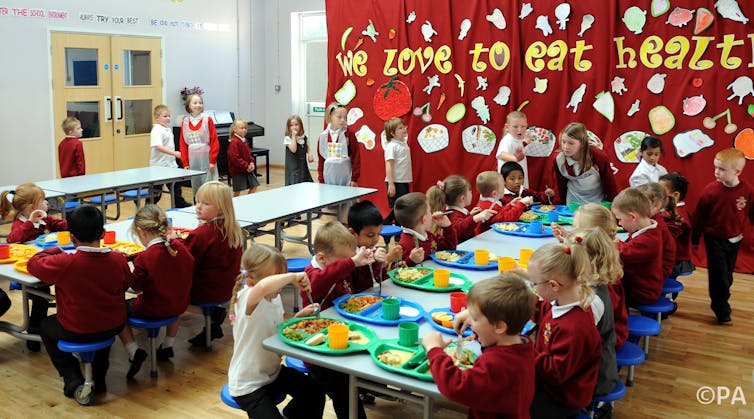
With the greatest will in the world, packed lunches often end up full of whatever happens to be left in the fridge or what can be grabbed on a tightly scheduled school run. But this can all now change as the deputy prime minister Nick Clegg’s free school meals are introduced for five to seven-year-olds at primary schools across England.
Children should eat food high in fruit and vegetables, high in complex (brown) carbohydrates, low in fat and sugar with a medium amount of protein. Free school meals will at last offer the chance for these young children to have at least one nutritionally sound meal a day. The Liberal Democrats have said they would extend the scheme to all primary school children if they are re-elected.
But eating is not just about nutrition. It’s a habit which is set in childhood and when it goes well it can be a pleasurable and easy part of our daily lives. But when it goes wrong, eating can lead to health problems such as obesity, diabetes and heart disease and also create a lifelong struggle with body image, anxiety, depression and eating disorders.
So let’s put the “school” back into school meals and hope that this one meal a day also makes it possible to teach young children the what, when, where and how of eating. This can create not only healthy nutrition but also a healthy approach to food.
What?
Children should have a varied diet, not only so they have the best chance of getting the nutrients they need but also so they try new foods, see food as interesting or different and also avoid getting picky or rigid about what they will and will not eat.
Meals that have boiled, mashed or chipped potatoes, pasta that comes alone or with sauce and even food that isn’t quite clear what it is can become a daily norm. Children get used to just eating what’s on offer. If teachers and parents present children with different options, and then make a point of saying “you are good at trying new foods” (even if they are not all the time), they can see themselves as open and confident individuals.
When?
School dinners occur at a pre-set time, in a predictable way each day and are called “dinners” to make them an occasion which is registered by the child. Children should eat at meal times and avoid snacking, eating on the move or mindless unhealthy eating in front of the TV or computer.
The regularity of the school dinner routine means children learn to feel and live with hunger (without reaching for a snack), then learn that meals are nicer if you are hungry. They also learn that eating a meal makes the hunger go away for longer.
Where?
Eating at the table adds to the sense of a meal and helps prevent mindless eating as the food is recorded, remembered and registered as “food”. But eating socially at a table is also important as it takes the pressure away from the food itself and makes it part of having friends, being together and catching up on the day.
The meal therefore becomes more about the chat than the food so the food can fill them up without becoming a preoccupation or worry. On top of this, children will try new food that they see other children (or teachers) eating and learn that food is just one of life’s many pleasures that can be enjoyed in an uncomplicated way.
How?
We eat when we are hungry, but we also eat when we are fed up, bored, cross or happy. As adults, food can be a crutch that becomes a problem when overused. As children, we learn this when food is used as a bribe (“do your homework and you can have a biscuit”); a reward (“well done, have some cake”); a distraction (“have some chocolate to cheer you up”); or a comfort (“I’m sorry your hamster died let’s have some sweets”). It works so well, that it’s easy to see why parents and teachers use it in this way.
But school dinners can be a chance to break this pattern. If the same food is there for everyone, at the same time, to be eaten together, both children and teachers can start to re-learn the how of healthy eating.
We want our children to eat a nutritionally sound diet in order have long and healthy lives. But we also want them to have a healthy approach to food to make these lives happy ones. Hopefully the “meal” in free school meals will give them the food their bodies need. But maybe the “school” can also give them a healthy approach to food to sort their minds out as well.
